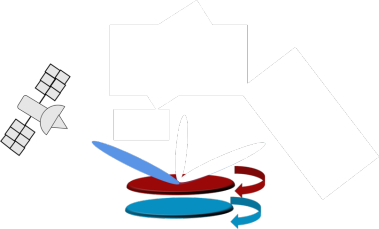
-
StatusOngoing
-
Status date2025-02-03
-
Activity Code7C.058
The objective of this project is to investigate geodesic lens antennas, and their ability to provide a cost-effective solution for Satcom mobile ground terminals. Geodesic lens antennas are associated with good scanning capabilities, and high efficiency. Beam scanning can be obtained by moving only the feed and multiple simultaneous beams can be produced by employing multiple feeds. However, geodesic lenses only provide beam forming in one plane so employing only a geodesic lens is not sufficient to meet the gain requirements for Satcom. In this project, we investigate how a geodesic lens can be employed with different technologies to produce a highly directive beam while maintaining the attractive properties of the geodesic lens. The goal is to develop an antenna system that can provide high directivity and wide-angle steerable radiation patterns at a low cost and with a compact size.
Geodesic lens antennas exhibit desirable properties such as high efficiency and good scanning capabilities. However, it's important to note that these antennas inherently provide beamforming in a single plane. Consequently, a method to enhance the directivity of the geodesic lens antenna must be explored. Two primary challenges are identified in this project:
-
Integrate the geodesic lens antenna with a structure designed to increase the directivity.
-
Preserve the attractive properties of the geodesic lens antenna following integration with the structure.
Most Satcom terminals on the market are either based on reflectors or arrays. Both those solutions have certain advantages and disadvantages. Reflector antennas are quite cheap and provide high-quality beams. However, reflectors tend to be bulky and are difficult to steer electronically and so have quite slow scanning speed. Systems using electronically reconfigurable arrays allow for fast scanning and low profile. However, when the number of elements in an array, which is necessary when the antenna is to be highly directive, the complexity of design and cost increases. Additionally, such arrays tend to be lossy at high frequencies. The proposed solution consists of a geodesic lens combined with a continuous transverse stubs (CTS). The solution scans using mechanical rotation that is sufficiently fast to track a satellite. Furthermore, the solution is more compact than a reflector solution but is also fully metallic so does not suffer as much losses as electronically steered arrays.
The main objective of the project is to develop highly efficient and compact steerable directive antenna for satellite communications. The main features of the proposed solution are:
-
Highly efficient antenna design. This is accomplished by having most of the parts fully metallic to reduce material losses.
-
Wide angle beam steering capabilities. This is achieved by employing a rotationally symmetric lens.
-
Mechanical scanning requiring low-torque actuators. This is again achieved by employing a rotationally symmetric lens so only a small feed needs to be moved in order to achieve beam scanning.
The antenna developed in this activity provide a mechanically steerable beam that require movement of only a small part of the system when steering. The antenna system might also be suitable for electronically steering. Further study is needed to confirm the viability of that idea. The system is composed of three main parts
-
Rotationally symmetric geodesic lens, which provides creates a linear source. For initial prototyping the lens is designed so it can be manufactured using CNC milling. For cheaper alternatives mold casting or metallic additive manufacturing can be considered for mass production.
-
CTS structure that slowly radiates the linear source created by the lens. This way a linear polarized highly directive beam is produced.
-
Polarizer array that transforms the linear polarization of the antenna to circular polarization.
The project is divided into four stages:
-
Review of product requirements and available state-of-the-art.
-
Study of different compression techniques and the applicability to the lens design. Different antenna solutions are proposed and verified in simulations and by studying state of the art.
-
Validation of the selected design.
-
Measurement of the manufactured prototype.
The project is completed, and the concepts are experimentally verified in a lab environment.



